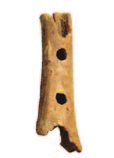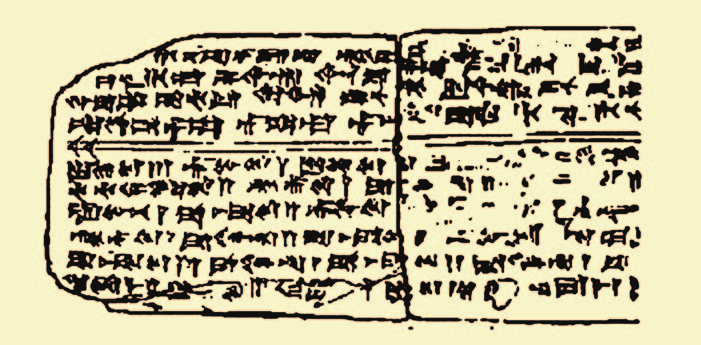How Music Works (54 page)
Authors: David Byrne
Tags: #Science, #History, #Non-Fiction, #Music, #Art

Bible tells us. We are told that it was the
sound
of God’s voice that caused the Nothing to become Something. I’m not given to being literal about such
things. I doubt that “Word” here means a syllable or an actual utterance. I can more easily picture this “Word,” this sonic event, referring to a celestial vibration than to an actual
word
. Maybe we could go a step further and imagine that this ancient metaphor reflects some kind of intuition regarding the Big Bang, which one can view as a kind of really really big “sound,” one that still radiates out from its theoretical beginning and from which was made our world and all the others. If
that
was the “Word” God was shouting, then we’re all in agreement. At any rate, it seems significant that the chosen metaphor was a word
and not a drawing, a text, or even a dance.
DAV I D BY R N E | 301


Though sound could conceivably be, in this scenario,
the
key to
creation, the Big Bang wasn’t exactly music. Lots of theories attempt
to explain how music first came into being. Some say music origi-
A
nated with the non-verbal sounds mothers make to their children,
while others connect music to sounds in nature or animal utterances,
or as a means of inducing warriors into a trance state. The musicolo-
gist Joseph Jordania suggests that complete silence is often perceived
as a sign of danger, so humming and whistling were used to fill those
scary empty spaces. The jury is still out on which of these theories is
correct, but all agree that music emerged at the same time people did.
B
The earliest evidence we have of early man actually making music
dates back about 45,000 years. Neanderthals and other “cave dwell-
ers” were playing flutes that seem to have been based around what
we now call diatonic scales. The diatonic scale is the musical scale
familiar to most of us today—seven notes, the eighth note being the
octave of the first one. If you play the white notes of a piano from C
to C, you are playing a diatonic scale. To the left is a photo of one of
these flutes that was found in Divje Babe, in what is now Slovenia.A
A Canadian musicologist, Robert Fink, proposes that the notes pro-
duced by the holes in this bone flute are the start of a diatonic scale—
do, re, mi, fa.1 Fink suggests that if one imagines an extended version of
the flute,B then the rest of the diatonic scale we use could be played on
it. Not everyone buys this, but there is strong evidence that the Sume-
rians (c. 3100–2000 BCE) and the Babylonians (c. 2000–1600 BCE)
used this same scale. A diatonic scale on cuneiform tablets found in
Nippur (present day Iraq) dates from 2000 BCE. Musical instruments
have been found at Mesopotamian burial sites, and pictures of musi-
cians at ceremonies playing lyres, drums, and flutes are on a mural in
the Tomb of the Harpists in Egypt that dates to 1200 BCE. The preva-
lence of relationships and intervals between notes that produce fifths,
fourths, and sixths on these instruments correspond to consonant har-
monies we still recognize. “Consonant,” in this case, means harmonies
that are felt to be “stable” and settled, while dissonant harmonies are
felt to be unstable, temporary, and “want” to move on to something
else. Consonant, according to these discoveries, is what we as humans
generally find harmonically comfortable to listen to, and this has led
302 | HOW MUSIC WORKS

scientists to believe that we might have an innate biological predisposition toward certain musical relationships.
Here is a reproduction of a tablet found in Ugarit, present-day Syria, with
the oldest bit of complete written music on it, from 1400 BCE.C It is described as a hymn to Nikkal, the goddess of orchards. There are instructions for the singer, and for the accompaniment music to be played on a lyre. Other cuneiform fragments describe how to tune the lyre, which is how we know they
were using a diatonic scale. To my surprise, some of these hymns even cite
the name of the composer. Already some individuals were recognized as being
good at this thing called music.
What did ancient music sound like? Though we can figure out the notes
that the flutes and lyres played—we can either play them or reconstruct
them—it’s a little harder to know what singers sounded like or how their
songs were structured. Did the singers holler or whisper? Did they sing with chest tones or whine through their noses? Musicologist Peter van der Merwe
suggests that Mesopotamian singers sang with intense but inwardly directed
emotion, somewhat like contemporary Assyrian musicians do. They sing as
if listening to themselves. It’s a gesture that conveys intensity, and implies that you are communicating with your interior feelings, as if the song were a message from someplace deep inside rather than simply being the manifestation of the ego of the person performing. The implication is that the singer is not so much a performer as a conduit, a vehicle. There’s a pretty direct
C
DAV I D BY R N E | 303
connection between this kind of singing and contemporary Flamenco vocal-
izing. Not much has changed.
There are nine-thousand-year-old flutes in China that can play scales very
similar to these Mesopotamian ones, which begs the question: Did we evolve
to prefer certain notes more than others? Have we developed a neurological
“ear” that is predisposed to enjoy the structured sounds that humanity has
come to call music? Even infants prefer the harmonies we think of as con-
sonant, and they can distinguish different scales. Infants can also hear what are called “relational pitches,” which means that you can sing “Happy Birthday” to a baby starting on any note you choose, and if the child knows the
song, there’s a good chance she will still recognize it. That might not sound so special, but it’s actually quite difficult, because the absolute notes will change completely if the singer starts on a different key. The third note in the melody will no longer be A, for example, but what we think of and recognize
as a melody will be the same. Machines can’t do this yet—they can only
compare melodies to an absolute reference. To present-day machines, a song
that starts in the key of C is different from one that starts in B, even though the melody might be identical. We have evolved many extremely specialized
skills—physical and neurological—that seem to be related to music mak-
ing. It’s something that must be important to our being homo sapiens, and
despite cultural differences, musical forms and structures are often shared.
We’ve been asking ourselves why we have this special relationship for a long, long time. What larger patterns in the universe make us gravitate to specific musical relationships and forms?
THE MUSIC OF THE SPHERES
The followers of Pythagoras (around 590 BC) were called Acousmatics
because they listened to his talks while he remained hidden behind a
curtain. Maybe this was intended to help them focus on his words rather than on what might have been distracting gestures. Pythagoras surmised that there might be a divine reason behind our tendency to find specific harmonies and
note intervals more pleasant to the ear than others. He pointed out that there were mathematical congruencies behind these notes—a phenomenon he first
observed when he passed by a blacksmith’s shop and noticed that the pings
304 | HOW MUSIC WORKS
of the various hammers fell along common musical intervals. Why? It was the
proportions of the varying weights of the hammers—a twelve-pound hammer
and a six-pound hammer produced pings an octave apart. Similarly, a string
stopped at 3/4 of its length produces a note that is 1/4 above the octave—the sound of the full-length string. This fourth harmony is extremely common,
and we find it pleasant. If the stop is 2/3 the length of the string, then the note is a perfect fifth. A stop at half the length produces a note that is an exact octave higher than the full length of the string. Needless to say, this is somewhat uncanny. Spooky, even. Why should this be?
Pythagoras surmised that the gods generally prefer small numbers such as
occur in these fractions, because simplicity is always more profoundly elegant.
Pythagoras was a bit of a numbers nut, so the fact that there were mathematic underpinnings to the most common musical harmonies was very exciting for
him. It was like unlocking a key to the universe. He further identified three kinds of music: instrumental, human, and celestial. Music played on instruments by mortals was viewed as a pale echo of the “original” celestial music, an idea that seems to presage Plato’s shadows-in-the-cave metaphor. The
celestial music, the music we attempt to imitate—where the divine harmo-
nies emanate from—actually does exist, Pythagoras said, and this music has
its source in the spheres that “hold” the planets. He believed that the planets were attached to revolving crystal spheres (how else could they stay up?), and that each planet, along with its crystal sphere, produced its own unique tone as it whistled through the cosmic ether. Hence the Music of the Spheres. The distances between the spheres (and their planets) were, of course, based on a series of relationships that followed these same “harmonic” and mathematical ratios, or relatively simple combinations of them. So the whole universe, or what was known of it at the time (the stars were thought to lie on these crystal spheres as well), was like a giant mechanical instrument producing a shifting and ever-morphing chord as the spheres creaked through the ether. The implication was that all earthly harmonies—the harmonies of all things, dead and
alive, both inside and out—were all based on those same ratios.
This idea lingers still. NASA recorded inaudible electromagnetic signals—
not even what we would call sound waves—as the probes
Voyager
and
Cassini
passed by a number of planets. Then these signals were processed and converted into sonic vibrations that fell within the range of human hearing. A
collection of these sounds was released as an album with the title
Symphony
DAV I D BY R N E | 305
of the Planets
. It’s basically a collection of ambient drones—quite nice ones, too, though Mercury is a little scary sounding. One online reviewer of these recordings credits the solar system with being a composer of ambient trance
music. “As if creation were performing for you,” he wrote.
Not surprisingly, these notes, as Pythagoras conceived them, produced the
most divine harmony imaginable—a great cosmic chord that created us and
everything else. The sound was so perfect, he said, that ordinary people like you and me couldn’t hear it. Pythagoras could hear it, though. It was claimed by his followers that Adam and Eve heard it, too, as God imparted to them the means to hear this perfect chord. Like links in a mystic chain, the Zoroastri-ans then passed the way of listening down to their disciples. It was said that Moses also heard it when he received the tablets of the ten commandments.
